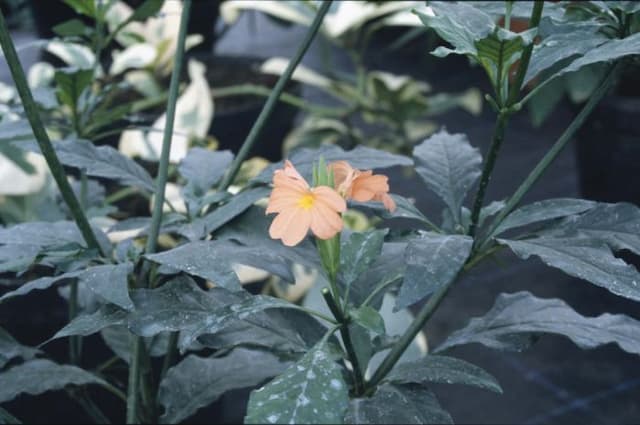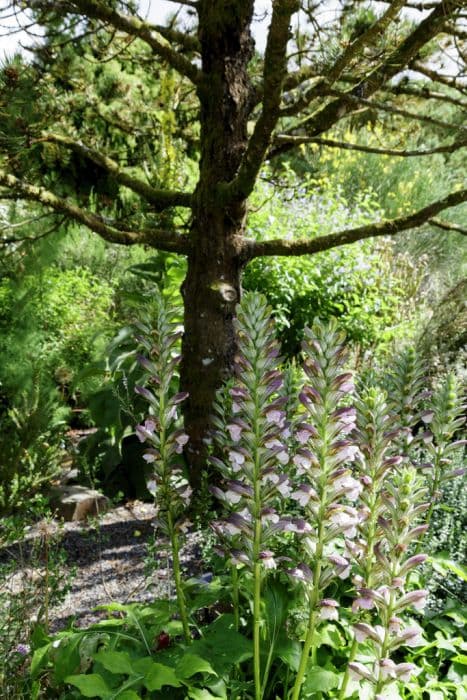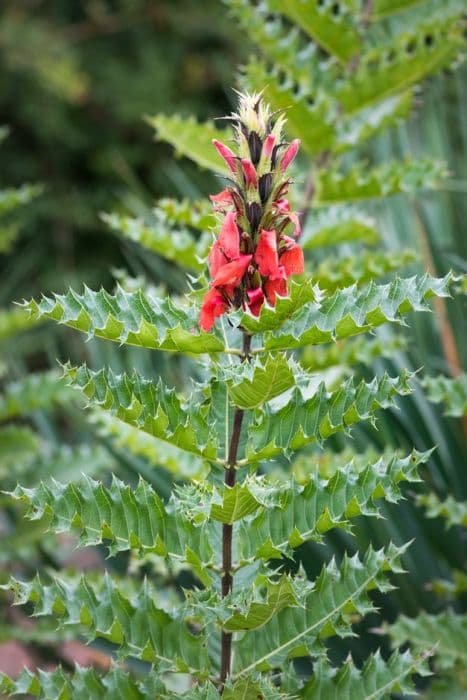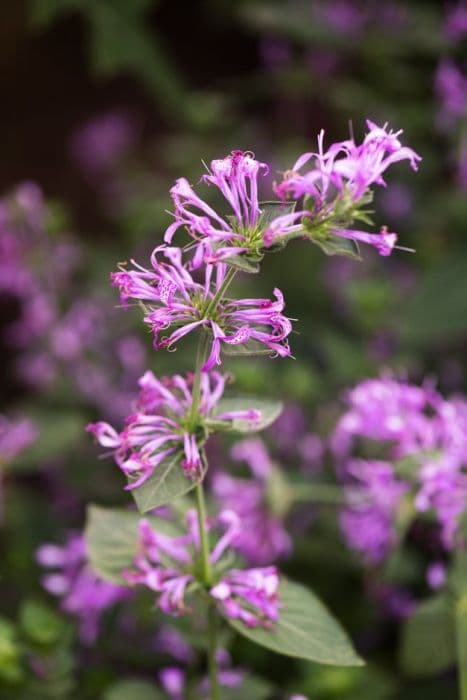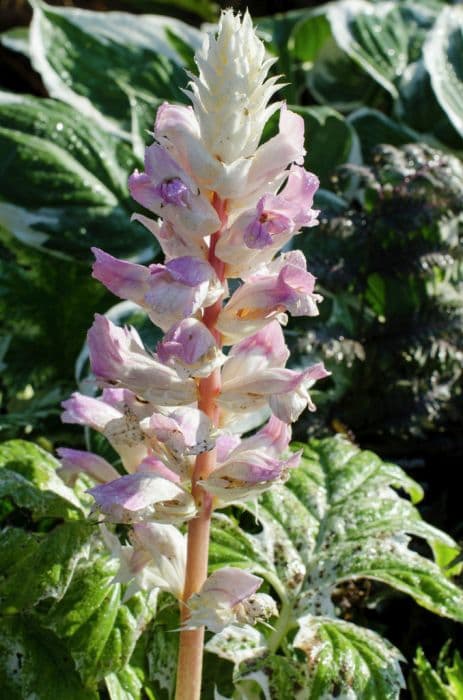Bear's breeches Acanthus mollis

ABOUT
Commonly known as bear's breeches, the Acanthus mollis is a perennial plant that is widely appreciated for its attractive foliage and striking floral displays. The leaves of this plant are large, glossy, and deeply lobed, with a texture that can be described as somewhat spiny to the touch, though they are not as prickly as some of its relatives. They emanate from a basal rosette, creating a lush and sculptural foliage clump that gives the plant a dramatic and architectural quality. The flowers of bear's breeches are equally distinctive. They are borne on tall, erect spikes that rise above the foliage, and the individual blooms are tubular and hooded, typically with a combination of soft white petals and purple or lilac bracts. These bracts are what give the floral spikes their showy and ornate appearance, often drawing comparisons to classical Corinthian columns and thus contributing to the plant's historical popularity in art and architecture. The overall allure of bear's breeches lies in its stately foliage and decorative flower spikes, which together produce a lush, classical look that's sought after in gardens and landscaping. It's a plant that is both bold in texture and form, providing an eye-catching element in any garden it graces.
About this plant
 Names
NamesFamily
Acanthaceae
Synonyms
Bear's Breeches, Sea Dock, Bearsfoot, Oyster Plant
Common names
Acanthus hispanicus, Acanthus latifolius, Acanthus longifolius, Acanthus lusitanicus, Acanthus niger, Acanthus spinosissimus, Acanthus spinosus, Acanthus hirsutus.
 Toxicity
ToxicityTo humans
Bear's breech, the common name for Acanthus mollis, has components that can cause skin irritations and reactions in some people upon contact. While having no major toxic properties, ingesting parts of the plant can lead to gastrointestinal discomfort, such as nausea, vomiting, or diarrhea. It is always advisable to avoid consuming parts of ornamental plants due to potential adverse effects.
To pets
Bear's breech is not listed as a highly toxic plant to pets. However, similarly to humans, if pets chew on or ingest parts of the plant, they could experience mild gastrointestinal upset, which may manifest as vomiting or diarrhea. It is advisable to keep an eye on pets and prevent them from eating ornamental plants to avoid these potential issues.
 Characteristics
CharacteristicsLife cycle
Perennials
Foliage type
Evergreen
Color of leaves
Green
Flower color
White
Height
3-4 feet (0.9-1.2 meters)
Spread
2-3 feet (0.6-0.9 meters)
Plant type
Herb
Hardiness zones
7
Native area
Mediterranean
Benefits
 General Benefits
General Benefits- Ornamental Value: Acanthus mollis, commonly known as Bear's Breeches, is valued for its large, deeply lobed, dark green leaves that are visually striking in garden designs.
- Landscape Design Flexibility: The plant's bold foliage and tall spires of flowers suit various landscape styles, from formal to cottage gardens.
- Drought Tolerance: Once established, Bear's Breeches has a good level of drought resistance, making it suitable for xeriscaping and water-wise gardens.
- Low Maintenance: This plant requires minimal care once it has settled into its location, with occasional watering and pruning sufficing.
- Attracts Pollinators: The plant's summer flowers attract bees and other pollinators, enhancing the biodiversity of the garden.
- Architectural Structure: The tall flowering stalks and detailed leaves of Bear's Breeches add architectural interest to garden compositions.
- Shade Tolerance: It can grow in partial shade, providing a foliage option for garden areas with less sunlight.
- Seasonal Interest: With a long blooming period in the summer and attractive foliage throughout the growing season, Bear's Breeches provides extended visual interest.
 Medical Properties
Medical Properties- Anti-inflammatory: Contains compounds that may help reduce inflammation.
- Analgesic: Traditionally used to alleviate pain.
- Emollient: Has soothing effects on the skin and may be used for its softening properties.
- Astringent: Can be used for its tightening effect on tissues; traditionally used to reduce bleeding.
- Healing: Used in traditional medicine to promote wound healing.
 Air-purifying Qualities
Air-purifying QualitiesThis plant is not specifically known for air purifying qualities.
 Other Uses
Other Uses- Acanthus mollis, commonly known as bear's breeches, can serve as a durable and robust ground cover, expanding through underground rhizomes to stabilize soil and prevent erosion.
- The spiny, architectural leaves of bear's breeches have been used historically in art and architecture as decorative motifs, specifically in Corinthian column capitals and various ornamental designs.
- Due to its large, textured leaves, bear's breeches provides a dramatic backdrop in floral arrangements and can last quite long as a cut foliage.
- The distinctive leaves of bear's breeches can be used in printmaking and painting, for their natural patterns make interesting stamps or stencils when coated with paint.
- In garden design, bear's breeches are often planted in large containers where their bold foliage forms a striking feature, adding depth and height to garden displays.
- This plant can be used for creating natural dividers or borders within a garden, its height and density proving an excellent visual barrier.
- The tall flowering stalks of bear's breeches, when dried, are sometimes incorporated into dried floral crafts and arrangements for their structural qualities.
- In the realm of photography and botanical illustration, bear's breeches make a popular subject due to their unique and deeply-veined leaf structure and splendid flower spikes.
- The plant can be used in educational settings, like botany classes or nature studies, to demonstrate plant structure, adaptations, and the lifecycle of perennials.
- Lastly, bear's breeches can function as a companion plant in gardens, by potentially masquerading as an unpalatable option due to its spiky leaves, thus deterring herbivores from more desirable crops.
Interesting Facts
 Feng Shui
Feng ShuiBear's Breeches is not used in Feng Shui practice.
 Zodiac Sign Compitability
Zodiac Sign CompitabilityBear's Breeches is not used in astrology practice.
 Plant Symbolism
Plant Symbolism- Artistic Inspiration: The leaves of Bear's Breeches have been widely used as motifs in classical architecture and art, symbolizing creativity and enduring aesthetic appeal.
- Resilience and Recovery: This plant has a strong root system that allows it to survive tough conditions, thereby representing strength and the ability to overcome adversity.
- Healing: In some traditions, Acanthus mollis is considered to have medicinal properties, thus embodying health and healing.
- Protection: With its spiny leaves, the plant has historically signified a safe haven or protection from harm.
 Water
WaterBear's breech should be watered deeply once a week, providing about one to two gallons of water per plant. This ensures that the moisture reaches the deep roots without overwatering. During hot, dry periods, you may need to water more frequently, ensuring the soil remains moist but not waterlogged. Reduce watering in the fall and winter when the plant is dormant. Always check the top inch of soil before watering; if it's dry, it's time to water.
 Light
LightBear's breech thrives in partial shade to full sun, but in hotter climates, it benefits from some afternoon shade. The ideal spot for this plant is one where it can receive morning sunlight and be protected from the intense heat of the midday sun. Avoid deep shade as it may lead to poor flowering and leggy growth.
 Temperature
TemperatureBear's breech prefers temperatures ranging from 50°F to 80°F. It can survive in temperatures as low as 15°F, but growth will be stunted. It's essential to protect the plant from extreme cold; mulching can help keep the root zone warm. Avoid exposing the plant to temperatures above 90°F, as this can cause stress.
 Pruning
PruningPrune Bear's breech to remove dead or damaged leaves and to promote healthy growth. The best time to prune is in late winter or early spring before new growth begins. Cut the plant back to about six inches above the ground every couple of years to rejuvenate it. Pruning also encourages a tidier plant habit and can help prevent disease by increasing air circulation.
 Cleaning
CleaningAs needed
 Soil
SoilBear's Breeches prefer a rich, well-draining soil mix with an ideal pH range of 6.0 to 7.0. A loam-based potting mix amended with compost and perlite or sand is suitable for good root growth and drainage.ращ
 Repotting
RepottingBear's Breeches should generally be repotted every two to three years to refresh the soil and accommodate root growth. Choose a pot that is one size larger than the current one to ensure sufficient space.
 Humidity & Misting
Humidity & MistingBear's Breeches thrive in average room humidity and do not have specific high humidity requirements, making it adaptable to most indoor environments.
 Suitable locations
Suitable locationsIndoor
Place Bear's Breeches in bright, indirect light indoors and water moderately.
Outdoor
Plant Bear's Breeches in partial shade and shelter from strong winds.
Hardiness zone
7-10 USDA
 Life cycle
Life cycleAcanthus mollis, commonly known as bear's breeches, begins its life cycle as a seed, germinating in spring to early summer when soil temperatures and moisture levels are adequate. The germinated seed develops into a seedling, establishing a basic root system and foliage through photosynthesis. As it matures, bear's breeches forms a clump of deeply lobed, dark green leaves, becoming a perennial herb with an extensive root system. The plant reaches flowering maturity, typically in early to mid-summer, producing tall spikes adorned with white or purplish flowers, each crowned with showy bracts. After pollination, often involving bees, the flowers develop into seed pods that eventually dry and release seeds for dispersal, thus completing the reproductive stage. In winter or dry periods, Acanthus mollis may become dormant, but it will resume growth with the return of favorable conditions.
 Propogation
PropogationPropogation time
Spring to early summer
Propogation: The most popular method of propagating Bear's breech, or Acanthus mollis, is by dividing its root clumps. This is typically done in the spring or fall when the plant is not in active growth. To propagate by division, carefully dig up the plant and shake off the excess soil. Use a sharp spade or knife to cut the root clump into smaller sections, ensuring that each division has a good portion of roots and at least one shoot. Replant the divisions at the same depth they were originally growing, spacing them about 24 inches (approximately 61 centimeters) apart to allow room for growth. Water the new plantings well to help establish them. This method promotes faster growth and flowering compared to seed propagation and maintains the characteristics of the parent plant.


